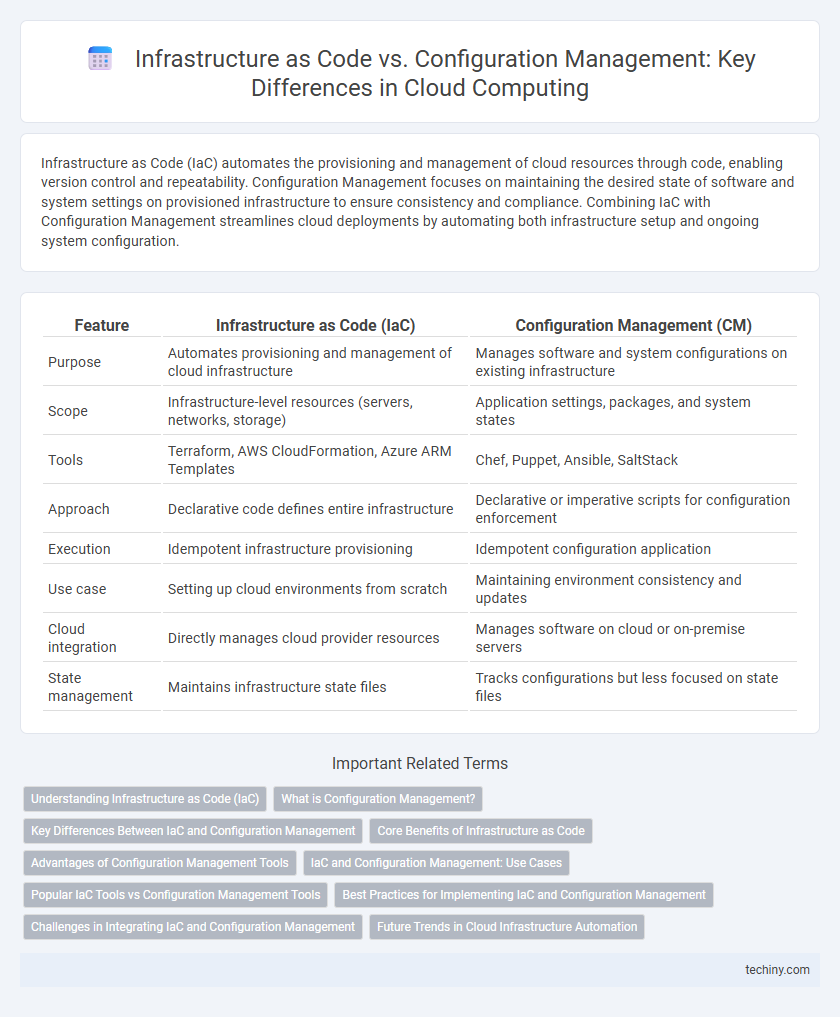Infrastructure as Code (IaC) automates the provisioning and management of cloud resources through code, enabling version control and repeatability. Configuration Management focuses on maintaining the desired state of software and system settings on provisioned infrastructure to ensure consistency and compliance. Combining IaC with Configuration Management streamlines cloud deployments by automating both infrastructure setup and ongoing system configuration.
Table of Comparison
| Feature | Infrastructure as Code (IaC) | Configuration Management (CM) |
|---|---|---|
| Purpose | Automates provisioning and management of cloud infrastructure | Manages software and system configurations on existing infrastructure |
| Scope | Infrastructure-level resources (servers, networks, storage) | Application settings, packages, and system states |
| Tools | Terraform, AWS CloudFormation, Azure ARM Templates | Chef, Puppet, Ansible, SaltStack |
| Approach | Declarative code defines entire infrastructure | Declarative or imperative scripts for configuration enforcement |
| Execution | Idempotent infrastructure provisioning | Idempotent configuration application |
| Use case | Setting up cloud environments from scratch | Maintaining environment consistency and updates |
| Cloud integration | Directly manages cloud provider resources | Manages software on cloud or on-premise servers |
| State management | Maintains infrastructure state files | Tracks configurations but less focused on state files |
Understanding Infrastructure as Code (IaC)
Infrastructure as Code (IaC) automates the provisioning and management of cloud resources by defining infrastructure through machine-readable configuration files. IaC enables consistent and repeatable deployments, reducing manual errors and increasing scalability in cloud environments. Unlike traditional configuration management, which focuses on software setup, IaC manages entire infrastructure lifecycles from servers to networks, aligning infrastructure with application requirements.
What is Configuration Management?
Configuration Management in cloud computing automates the process of maintaining the consistency of a system's performance, functional, and physical attributes throughout its lifecycle. It involves tools such as Ansible, Chef, and Puppet to manage software configurations, establish desired states, and enforce compliance across servers and infrastructure components. Unlike Infrastructure as Code, which focuses on provisioning hardware resources, Configuration Management ensures the continuous deployment, update, and monitoring of software environments.
Key Differences Between IaC and Configuration Management
Infrastructure as Code (IaC) automates the provisioning and management of entire infrastructure environments through descriptive code, ensuring consistent and repeatable deployments. Configuration Management focuses specifically on maintaining and enforcing the desired state of software and system configurations on existing servers or resources. Key differences include IaC's capability to create and tear down infrastructure resources, whereas Configuration Management primarily modifies configurations within already provisioned environments.
Core Benefits of Infrastructure as Code
Infrastructure as Code (IaC) enables automated provisioning and management of cloud resources through machine-readable definition files, ensuring consistency and reducing manual errors compared to traditional Configuration Management. Core benefits of IaC include rapid deployment, version control integration, and scalable infrastructure replication, which streamline DevOps workflows and enhance collaboration. This approach accelerates infrastructure changes while promoting reproducibility and compliance in dynamic cloud environments.
Advantages of Configuration Management Tools
Configuration management tools provide automated, consistent system setup and software deployment across multiple servers, reducing manual errors and increasing scalability. They enable real-time tracking of configuration changes, enhancing system stability and security compliance. These tools streamline infrastructure updates and ensure environments remain uniform, minimizing downtime and accelerating development cycles in cloud computing environments.
IaC and Configuration Management: Use Cases
Infrastructure as Code (IaC) enables automated provisioning and management of cloud infrastructure using declarative scripts, ideal for consistent environment setups and rapid scaling. Configuration Management focuses on maintaining system state and software configurations across servers, often applied for patch management and ongoing updates. Organizations leverage IaC for infrastructure deployment while using Configuration Management tools to enforce application configuration and compliance throughout the application lifecycle.
Popular IaC Tools vs Configuration Management Tools
Popular Infrastructure as Code (IaC) tools like Terraform, AWS CloudFormation, and Pulumi enable automated provisioning of cloud resources through declarative templates, ensuring consistent and repeatable infrastructure deployments. Configuration management tools such as Ansible, Puppet, and Chef focus on maintaining the desired state of software and system configurations across servers, automating tasks like package installation and service management. While Terraform excels in orchestrating infrastructure at scale, Ansible is widely favored for its agentless architecture and ease of managing system configurations, making both complementary in comprehensive cloud automation strategies.
Best Practices for Implementing IaC and Configuration Management
Implementing Infrastructure as Code (IaC) and Configuration Management effectively requires version control systems such as Git to track changes and enable collaboration. Utilizing modular and reusable code structures enhances maintainability and scalability in tools like Terraform, Ansible, or Puppet. Automated testing and continuous integration pipelines ensure reliable deployments and minimize configuration drift in cloud environments such as AWS, Azure, or Google Cloud.
Challenges in Integrating IaC and Configuration Management
Integrating Infrastructure as Code (IaC) with Configuration Management (CM) often presents challenges such as synchronization issues, where IaC scripts and CM tools may conflict over resource states, leading to deployment inconsistencies. Managing state drift becomes complex as IaC focuses on provisioning infrastructure while CM handles software and system configurations, requiring tightly coordinated workflows for seamless automation. Ensuring compatibility between diverse IaC frameworks like Terraform or CloudFormation and CM tools such as Ansible, Puppet, or Chef demands careful planning to avoid overlap and maintain infrastructure stability.
Future Trends in Cloud Infrastructure Automation
Infrastructure as Code (IaC) and Configuration Management are evolving towards greater integration with AI-driven automation, enabling predictive scaling and self-healing cloud environments. Future trends highlight increased adoption of declarative languages combined with machine learning to enhance infrastructure provisioning accuracy and speed. The convergence of IaC with GitOps practices is set to streamline continuous deployment workflows, reducing human error and improving system resilience in cloud infrastructure automation.
Infrastructure as Code vs Configuration Management Infographic

 techiny.com
techiny.com